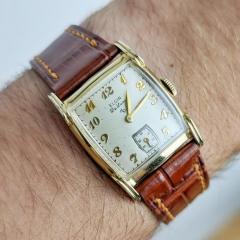Watch loses minutes per day; timegrapher reads fine
-
Recently Browsing
- No registered users viewing this page.
-
Topics
-
Posts
-
By Michael1962 · Posted
Aren't corners of rooms a bugger though as it is really difficult to use the space underneath the intersection of the two benchtops. Lazy Susans are an idea I suppose. Somewhere to be able to put tools/soldering iron/testing machines that aren't needed on the bench top all the time. It is a bit tight in there, but at least I won't have to move great distances to get to another area. I need to get hold of another chair to have at the cleaning bench. I'll stand all the time at the lathe and I already have the still for the workbench. Need to get the power sorted now and move the LED lights for over the workbench. There are four downlight in the ceiling that are currently halogen bulbs. Really quite bright so that's good. Ceiling fan as well. What else could one hope for? -
By Neverenoughwatches · Posted
So all that glitters is not gold when it comes to buying from ebay ( in fact very very rarely) i bought this as554 a few months ago. It was it's dial that attracted me to the joblot, which turned out to be printed on a postcard, that was the first red flag. During disassembly many faults were discovered as listed above, but i was prepared to soldier on and see what i could achieve. I managed to make a setting lever for it which was a great learning experience and also correctly shape and de rust the hairspring. Turning my attention to the balance assembly i have hit a road block. The staff broke when removing the roller but that wasn't so much of an issue as it was quite deformed anyway. I also had several AS554 staffs that I could replace it with, problem is they dont measure up the same. I thought i had identified the movement correctly but what i think has happened is some heavy modification has taken place to make an incorrect staff fit. A nos staff is a slack fit on the balance wheel, the roller and the collet. The balance wheel has also been filed to within an inch of its life. I'm starting to doubt my identification of the movement either that or someone has converted the movement into a pure nugget of trash. Bit disappointed as i managed to get the train to spin lovely and put a good few hours into the setting lever. A balance complete might be the only option if one is available but you know when you are just wasting money. My thoughts are to make and modify something else to fit and work if that is possible, any ideas anyone ? -
By Neverenoughwatches · Posted
Looking good Michael -
By Michael1962 · Posted
My second iteration. Cleaning to be underneath the towel rails. That makes sense. Moved the fridge and the maching/printing table around to the right. Changed the lathe to be used over the end of the bench. Not much room in front of the 3D printer, but you don't have to stand there while it is doing its thing. I may swap the fridge and the machining/printing bench yet. Not sure. And the 'doing' area. The power that was brought in for tha spa was 30A I think, so there will be more power than I need. I will have to check how level the benches are as well as find a spot for the movement testing rig to go. The tiles do have a fall toward the drain so I will have to work something out to be able to level the rig easily no matter where I put it. I'm also going to cut some slots in the bottom for pendulum clearance and some squares in the top section to be able to better see the movement. I'm getting more excited now. -
By Neverenoughwatches · Posted
Thanks Rich and scott for that information, so much more to learn.
-






Recommended Posts
Join the conversation
You can post now and register later. If you have an account, sign in now to post with your account.
Note: Your post will require moderator approval before it will be visible.